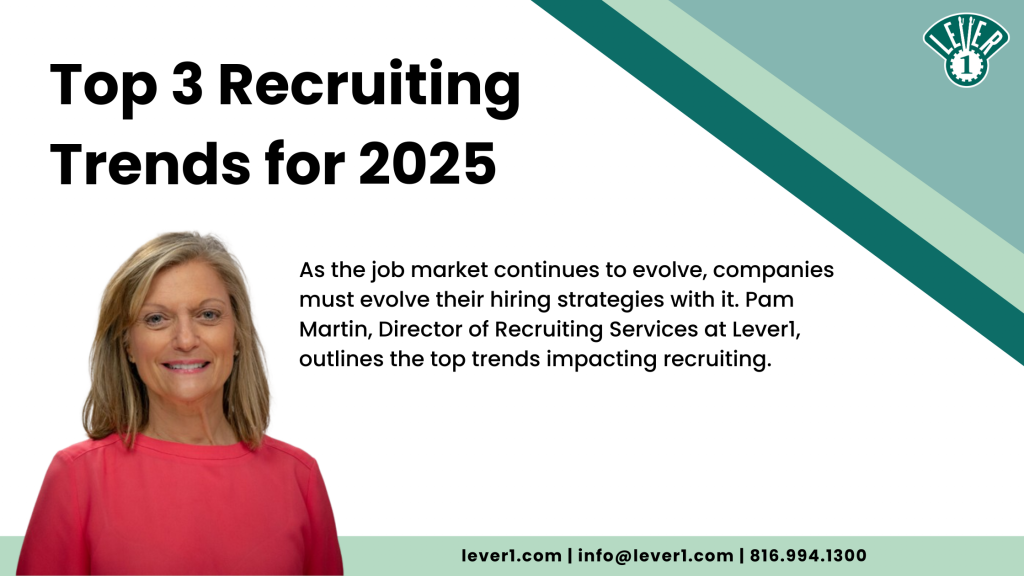
From building proactive talent pipelines to leveraging AI in recruiting and embracing pay transparency, companies are shifting their strategies to attract and retain top-tier talent in an increasingly competitive job market.
The hiring landscape is going to shift in 2025 and businesses will need to stay ahead. Are you ready to adapt and ensure your hiring process is efficient, equitable, and aligned with the expectations of today’s workforce?
Let’s explore the key trends shaping recruitment in 2025 and how you can set your organization up for success.
Proactive Candidate Engagement
We are going to see a change in how we find candidates in 2025. Proactive candidate engagement is emerging as a trend which is a shift to reactive hiring. The goal is to create long-term talent pipelines that companies and recruiters can return to when positions open up. This change to nurturing relationships with potential candidates before roles become available will reduce time spent on the hiring process.
A recent survey showed 84% of recruiters said that engaging passive candidates is becoming important in lower and middle-level roles and for bringing top talent into the funnel. Social media platforms and talent communities play a significant role in keeping candidates connected and engaged, while employer branding efforts ensure businesses stay top-of-mind. This approach not only reduces time-to-hire but also improves the quality of hires, as candidates are more informed and aligned with company values.
By prioritizing ongoing engagement, organizations can create a steady stream of qualified, motivated candidates ready to step into roles as opportunities arise, ensuring resilience in a competitive job market.
Use of AI in Recruiting
In 2025, we will continue to see artificial intelligence (AI) and applicant tracking systems (ATS) redefining the recruiting landscape. ATS platforms are now essential tools for talent acquisition, automating time-consuming tasks such as reviewing resumes, candidate ranking, and interview scheduling.
Partnering the technology and the personalization that comes with a recruiter, candidates will experience a seamless and worthwhile experience. This experience will lead to a more positive view of your company and their potential employment.
By combining AI and ATS capabilities, companies can streamline their hiring processes, reduce time-to-hire, and maintain a competitive edge in sourcing and retaining top-tier talent. The challenge for 2025 lies in leveraging these tools without losing the human touch that ensures a meaningful connection between employers and candidates.
Pay Transparency
Though only a few states and municipalities have enacted pay transparency laws as of today, they are becoming increasingly popular. Even if your state and local government don’t have pay transparency laws in place, you could still be losing out on candidates if you don’t include a salary range with your job posting.
Studies show four out of five workers said they are unlikely to apply for a job that doesn’t provide a pay range. Candidates now expect clear, upfront salary information during the hiring process, driven by changing regulations and a growing demand for fairness and equity. Companies embracing pay transparency are using it as a competitive advantage, showcasing their commitment to trust and accountability. Beyond compliance, transparent compensation practices help attract top talent and enhance employee retention.
For companies with remote employees, it should be noted that some states require transparency for remote jobs, while others only require it for hybrid or in-office roles. Check with your HR and Recruiting team to see how this could affect your hiring decisions or reach out to a Lever1 expert to get more information.
Pam Martin | Director of Recruiting Services
Pam Martin is our Director of Recruitment Services. Her strengths include relationship building among clients and candidates alike in order to optimize the recruiting match. She is active in a variety of key networking organizations including the Association for Corporate Group of Kansas City, Financial Executives Networking Group (FENG), and the Corporate Growth Group.

